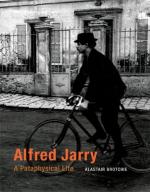|
This section contains 6,291 words (approx. 21 pages at 300 words per page) |

|
SOURCE: Stillman, Linda Klieger. “Machinations of Celibacy and Desire.” L'Esprit Créateur 24, no. 4 (winter 1984): 20-35.
In the following historically-grounded essay, Stillman examines Jarry's work, especially Le Sûrmale, in the context of the rapidly developing technology at the turn of the century and discusses the ways in which Marcueil, the automaton-like bicycling hero of Le Sûrmale, is machine-like in both love-making and athletics, she notes that Jarry “invented” a “time machine” and a “machine to inspire love,” which caused a stir in the art world of the late nineteenth century.
Machines, and technology in general, have been systematically associated with human progress and with predictions of life in the future. From the late eighteenth century, when the notion of progress as continual, rapid technological (and social) change captured the popular imagination, literature has concerned itself with coherent and comprehensive prophecies of over-achieving gadgets and utopian robotics. During...
|
This section contains 6,291 words (approx. 21 pages at 300 words per page) |

|


